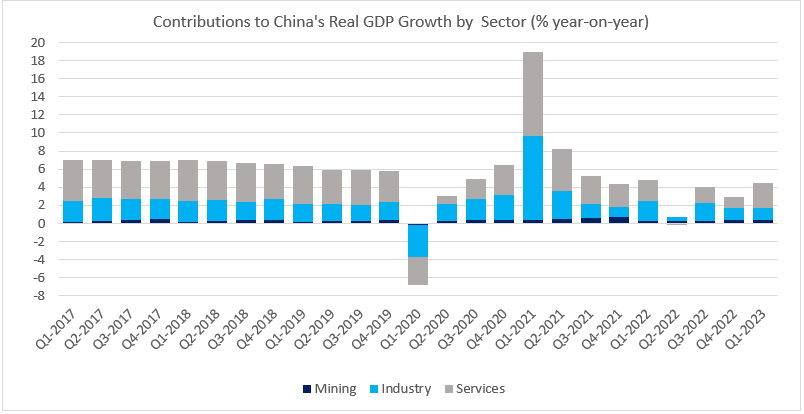China Growth – Reboot and Rebalance
18 April 2023
Read Time 2 MIN
Global Growth Outlook
China’s stronger-than-expected Q1 GDP number (4.5% year-on-year) gave more credence to the “two-speed” global growth story, which creates more opportunities for emerging markets (EM) assets to perform well in the coming months. Even though the IMF spring meetings eased concerns about a recession in advanced economies, both the U.S. and the Eurozone are expected to expand by about 1% or so this year in real terms. Meanwhile, China’s Q1 GDP print suggests that both the consensus growth forecast for 2023 (5.3%) and the official growth target (about 5%) might be too conservative. The next question is which emerging markets are better positioned to benefit from a stronger rebound in China – and this is where China’s changing growth drivers come into play.
China Recovery
China’s Q1 recovery was led by consumption (see chart below), including post-reopening “revenge” spending on services and travel, among other things. A big upside surprise in March’s retail sales (up by 10.6% year-on-year) seconded this conclusion. This, in turn, gave rise to suggestions about the frontloaded recovery that might lose steam later in the year. “Revenge” spending is not going to last forever, of course, but there is also a possibility that housing can pick up the baton in H2 if the current real estate trends – which show clearer signs of recovery – continue. Further policy calibration can definitely help to boost property construction, as well as address such obvious weaknesses as private investments, which continued to lag well behind state-owned peers.
EM Spillovers From China
China’s recovery is now more “inward-looking”, limiting positive spillovers to EM manufacturing, but still offering support to services (especially tourism) and commodities. And if growth continues to surprise to the upside, we might see more concerns about potential inflation spillovers down the road, which can intervene with a super-supportive H2 base effect across EM. Other potential risks that might slow or temporarily disrupt the disinflation process in EM include Argentina’s mega-drought and a higher risk of El Nino (a 40% probability, according to a recent report from Deutsche Bank). Stay tuned!
Chart at a Glance: China Growth – Services Spring Back To Action

Source: Bloomberg LP.
Related Insights
IMPORTANT DEFINITIONS & DISCLOSURES
This material may only be used outside of the United States.
This is not an offer to buy or sell, or a recommendation of any offer to buy or sell any of the securities mentioned herein. Fund holdings will vary. For a complete list of holdings in VanEck Mutual Funds and VanEck ETFs, please visit our website at www.vaneck.com.
The information presented does not involve the rendering of personalized investment, financial, legal, or tax advice. Certain statements contained herein may constitute projections, forecasts and other forward looking statements, which do not reflect actual results. Information provided by third-party sources are believed to be reliable and have not been independently verified for accuracy or completeness and cannot be guaranteed. Any opinions, projections, forecasts, and forward-looking statements presented herein are valid as of the date of this communication and are subject to change without notice. The information herein represents the opinion of the author(s), but not necessarily those of VanEck.
The views contained herein are not to be taken as advice or a recommendation to buy or sell any investment in any jurisdiction, nor is it a commitment from Van Eck Associates Corporation or its subsidiaries to participate in any transactions in any companies mentioned herein. This content is published in the United States. Investors are subject to securities and tax regulations within their applicable jurisdictions that are not addressed herein.
All investing is subject to risk, including the possible loss of the money you invest. As with any investment strategy, there is no guarantee that investment objectives will be met and investors may lose money. Diversification does not ensure a profit or protect against a loss in a declining market. Past performance is no guarantee of future results.
